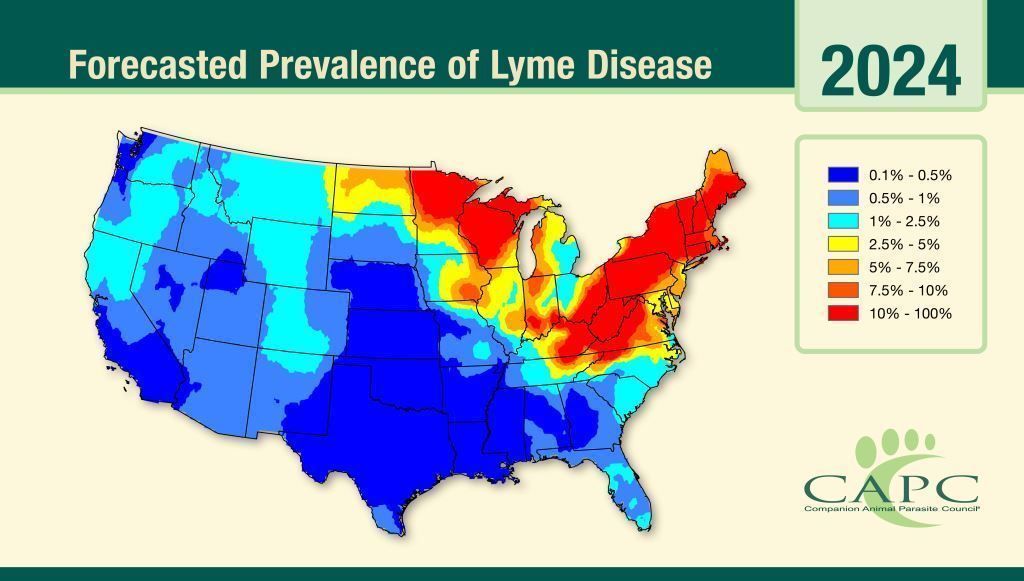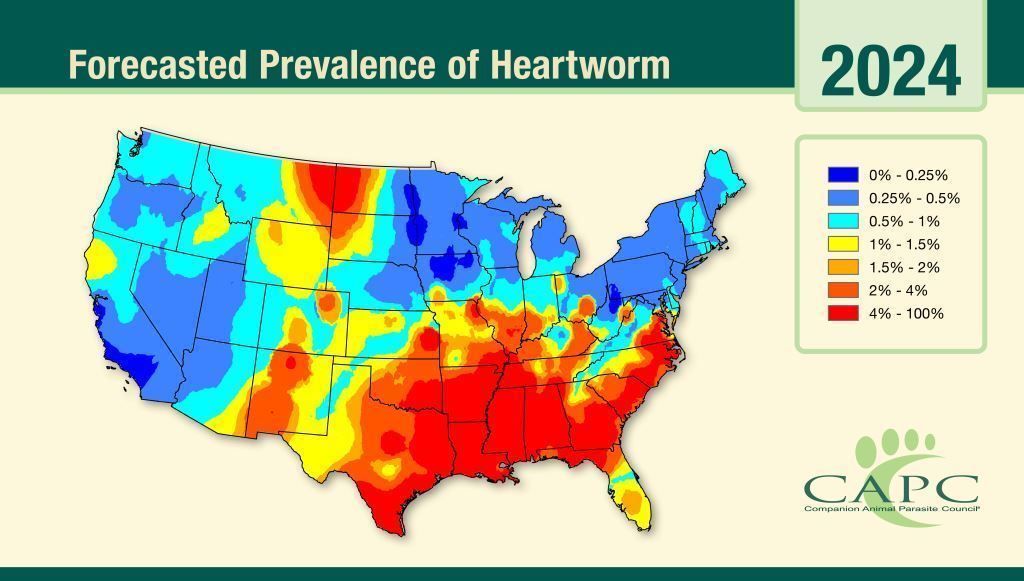Companion Animal Parasite Counsel shares 2024 Pet Parasite Forecast
The forecast is predicting parasitic pet diseases will spread further this year
Companion Animal Parasite Council- Lyme Disease Forecast(Images courtesy of Companion Animal Parasite Council)

Companion Animal Parasite Council (CAPC) issued a warning of the ongoing expansion of heartworm, Lyme disease, and other tick-borne diseases throughout the United States in 2024. Based on CAPC’s 2024 Pet Parasite Forecast, Lyme disease and other tick-borne diseases are continuing to spread across the US. According to an organizational release,1 CAPC has been providing an accurate forecast on parasitic diseases of pets for over 12 years and has demonstrated an almost perfect correlation between the forecast values and actual readings for the year, when compared to reported laboratory results from companion animals in the US.
Within the forecast, CAPC reported that ticks and mosquitoes continue to remain the principal transmitters of pet and human vector-borne diseases, The forecast found that Lyme, anaplasmosis, and ehrlichiosis specifically are advancing into North Carolina, Kentucky, and California. Heartworm disease is being spread throughout the mid-Atlantic region and pushing northward from mosquitoes.1 The last several years have presented a massive increase in mosquito-borne and tick-borne diseases. According to the CDC, within the US, cases tripled from 27, 388 cases in 2004 to 96,075 cases in 2016.2
Companion Animal Parasite Council- Heartworm Forecast

CAPC disclosed that contraction risks of Lyme, anaplasmosis, ehrlichiosis, and heartworm are increasing because of some of the following factors:
- Changes in wildlife host and vector (mosquito and tick) densities.
- Increasing international trade and travel.
- Land use, urbanization, and human population growth.
- Recently discovered vectors, such as the invasive Asian long-horned tick in the eastern US.
- Rehoming of pets across the country.
- Short- and long-term changes in climatic conditions.
“What was true before may not be true today when it comes to the local threat of parasites to our pets and families,” said Heather Walden, MS, PhD, president of the CAPC Board and associate professor at the University of Florida College of Veterinary Medicine. “Over the past 12 years, we have seen the movement of parasitic diseases and the vectors that carry them expand to new areas, signaling the need for pet owners to test their pets every year and protect them year-round.”1
When it comes to creating the annual forecast, CAPC disclosed it is a collaborative effort between parasitologists and statisticians who are conducting ongoing research and data interpretation in top academic institutions across the country. The goal of the enlisted professionals is to gain a better understanding and monitor vector-borne disease agent transmission along with the changing life cycles of parasites. Currently, there are multiple peer-reviewed articles about the forecast that demonstrate a consistent and weighted correlation of 0.9 and higher than actual laboratory results to demonstrate the high accuracy of the CAPC Forecasts.
Reference
- Nonprofit Companion Animal Parasite Council (CAPC) Warns Parasitic Pet Diseases Will Spread Further in 2024. News release. Companion Animal Parasite Council. April 17, 2024. Accessed April 19, 2024.
- Petersen LR, Beard CB, Visser SN. Combatting the Increasing Threat of Vector-Borne Disease in the United States with a National Vector-Borne Disease Prevention and Control System. Am J Trop Med Hyg. 2019;100(2):242-245. doi:10.4269/ajtmh.18-0841
2 Commerce Drive
Cranbury, NJ 08512
All rights reserved.